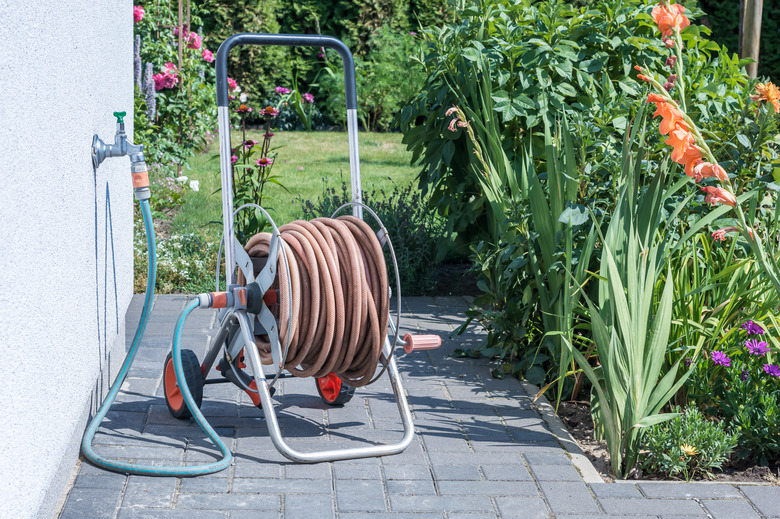How To Remove Stuck Garden Hoses
We may receive a commission on purchases made from links.
In the spring when winter browns and grays are replaced by green and you're eager to start sprucing things up outside, it can be frustrating to see that the hose you need to remove from the spigot, or hose bib, won't budge. You twist that little fitting till your hands hurt, finally putting outdoor projects on hold so you can figure out what removes a garden hose from a spigot when corrosion and neglect have created an annoying obstacle and a big headache.
The good news is that there's more than one way to go about it. If the first approach you try doesn't work, it's a safe bet that one of the other methods will loosen the grip. You just need to make sure you don't do damage to the fittings or to the spigot.
Warning
To avoid sustaining cuts from pieces of cut metal or from metal edges, wear protective gloves when trying to remove a stubborn hose fitting.
How to Remove a Hose by Twisting
How to Remove a Hose by Twisting
It may be possible to break the fittings free of each other by twisting them using either two tongue-and-groove pliers or two pipe wrenches, with one firmly holding the hose bib while you crank with the other to unscrew the hose fitting. Attempting to twist the hose fitting without holding the faucet securely with the other tool can easily result in damage to the spigot. Gently work the fitting side to side and front to back to help break loose anything obstructing the threads inside.
It's important to adjust the tool you're using so that all three inside edges rest against the round fitting. This prevents squeezing two sides of the fitting and pushing it into an oval shape, or getting it "out of round," which can make removal even more challenging.
In addition to spraying lubricating products, like WD-40, into the threads to loosen things up, you can try to twist off the hose fitting after applying a rust-busting product. Using CLR (calcium, lime, and rust remover) and an old toothbrush, scrub all around the connection between the hose and spigot. After waiting one hour, try twisting off the hose fitting. If this is unsuccessful, spray the fittings with PAM cooking spray. Using either two tongue-and-groove pliers or two pipe wrenches, try to work the fittings loose.
Because heating metal can cause it to expand, try using a heat gun or hair dryer on the fitting to see whether it will help loosen the grip. A heat gun may work better than a hair dryer since it reaches higher temperatures and produces a more concentrated airflow.
How to Remove a Hose Using a Hacksaw
How to Remove a Hose Using a Hacksaw
When it's clear that the hose fitting simply will not twist off, you'll have to pull out your hacksaw. Using your hacksaw, you'll cut into the fitting at a 45-degree angle — not in the same direction that the threads run. Be careful not to cut too deep or you'll damage the threads on the spigot. Create just enough of a slot to allow insertion of a screwdriver so you can pry out the fitting and twist it off.
How to Avoid the Problem
How to Avoid the
Problem
After laboring to free your garden hose from the hose bib, you'll want to prevent recurrences of the problem. There are several ways to keep your garden hose from becoming stuck to the outdoor spigot. First, the ends of spigots are usually brass, and aluminum corrodes and fuses to brass quickly, so if your hose has aluminum fittings, be sure to remove the hose from the faucet at least three times each year. Ultimately, it's a good idea to buy a hose that comes with brass fittings.
Another approach involves installation of quick-connect devices on the hose and spigot that allow you to simply insert the hose with a click into the spigot, completely avoiding twisting threaded ends together. Most quick-connect devices come in brass, but some are available in stainless steel, which is even more resistant to corrosion.
References
- 1 Tom Plumber: Garden Hose Stuck to Spigot? Here's the Best Way to Remove It!
- DIYHIPChicks: Garden Hose Stuck on Faucet (Plus Leak Prevention Tips)
- This Old House: How To Choose and Use Pliers and Wrenches
- MTM Hydro: How Many Garden Hose Fittings Do You Need?
- National Gardening Association: A Warning About Hoses With Aluminum Fittings
- Tools First: Heat Gun vs. Hair Dryer – Can You Use a Hair Dryer Instead?
- Garden Tools & Instruments: How To Loosen a Tight Hose on a Spigot
